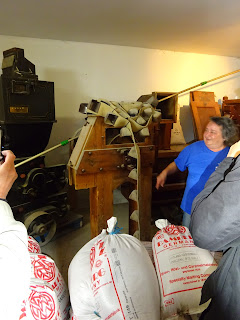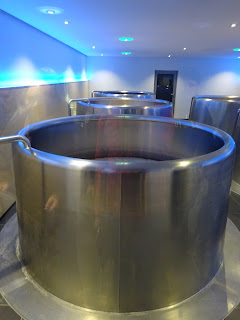The proto-prod menace might explain why near the brewery there was what looks like a statue of a heavily armed Mary. I'm sure she doesn't normally carry a sword.
We were going to Spital brewery, which dates back nearly 800 years, originally being linked a hospital a bishop founded. The hospital is now an old people's home, but they still seemed linked and it still looks religious.
We were interested in more temporal matters though. The group I was in started with the bottling line, and it was a feat of engineering that they'd managed to cram it in to the space it filled. It was smaller than most of the lines we saw on the tour but still pretty flash.
 |
| The bottle washer |
 |
| The filler |
There were two vessels in the brewhouse, a mash/wort kettle and a lauter tun.
They produce 15,000 hl of beer per year.
The whirlpool was in the next room.
As an old brewery they had various bits of crap lying around, which is always good to see.
And some sacks of malt from Weyermann, which we would be visiting soon.
They made their own malt up until 1970 and we got to have a look around the old maltings.
Some of the malt goes into three tonne silos.
They generally allow 20-25% free board on the 4.8 m deep vessels giving a working volume of 130 hl.
The brewlength is 60 hl so two brews can go in one FV.
The FVs have two cooling jackets and a cooled cone, the angle of which is 70°. Fermentation is carried out a 10°C.
The largest conditioning tank holds 185 hl and lagering is carried out for four to six weeks, depending on the beer.
This beers were not just in traditional German styles, with some modern innovations in evidence.
I don't suppose they've made IPA for much of the brewery's history.
Bavaria might have a conservative reputation, but this is not universal. Indeed, when we got to our hotel we saw a Bavaia that Erich Mühsam might have approved of.
And I even had Léo Ferré on my bedroom wall! How cool is that?
 |
| They are not one in one hundred, and yet they exist. |






















No comments:
Post a Comment